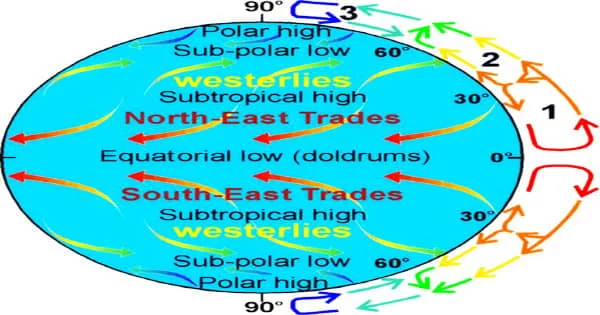The global wind circulation patterns in the upper atmosphere of a planet, 120 to 300 kilometers above the surface, are documented for the first time in a report published in Science. Unlike many previous assessments of Earth’s high atmosphere, the conclusions are based on local observations rather than indirect measurements.
However, it did not occur on Earth; rather, it occurred on Mars. Furthermore, the data came from an instrument and a spacecraft that weren’t designed to acquire wind measurements in the first place. The unequal heating of the Earth’s surface produces large global wind systems. The surface currents of the oceans are driven by these worldwide wind systems.
Because the Earth rotates, global winds do not flow directly from north to south or south to north. In the Northern Hemisphere, all winds appear to curl to the right as they move. Winds appear to curl to the left in the southern hemisphere.
Mehdi Benna and colleagues proposed to the Mars Atmosphere and Volatile EvolutioN (MAVEN) project team in 2016 that they remotely reprogram the MAVEN spacecraft and its Natural Gas and Ion Mass Spectrometer (NGIMS) instrument to conduct a one-of-a-kind experiment.
They wanted to investigate if sections of the instrument that were ordinarily immobile could “swing back and forth like a windshield wiper fast enough,” allowing the gadget to collect new data.
Initially, the MAVEN project team was hesitant to make the changes suggested by Benna and his colleagues. MAVEN and NGIMS, after all, have been orbiting Mars since 2013, and they were doing a great job of collecting data on the composition of the Martian atmosphere.

Why would you jeopardize all of that? Benna and his colleagues believed that this research will gather new types of data that would shape our understanding of Mars’ upper atmosphere, inform analogous studies on Earth, and aid our understanding of planetary climate.
It’s a clever re-engineering in flight of how to operate the spacecraft and the instrument. And by doing both the spacecraft doing something it was not designed to and the instrument doing something it was not designed to do we made the wind measurements possible.
Mehdi Benna
While brainstorming how to create an instrument that could collect information about global circulation patterns in Earth’s upper atmosphere, Benna, a planetary scientist at the NASA Goddard Space Flight Center with the UMBC Center for Space Sciences Technology (CSST), came up with the windshield-wiper idea. MAVEN and NGIMS, he realized, could perform the same thing on Mars if they worked together, and they were already in space.
After Lockheed Martin, the spacecraft builder, confirmed that the alterations might be achievable without destroying the satellite, Benna and his colleagues persuaded the MAVEN mission leadership to give their idea a go with a little persistence and a lot of preliminary analyses.
“It’s a clever re-engineering in flight of how to operate the spacecraft and the instrument,” Benna says. “And by doing both the spacecraft doing something it was not designed to and the instrument doing something it was not designed to do we made the wind measurements possible.”
Ripple effect
Yuni Lee, also of UMBC’s CSST, and colleagues from the University of Michigan, George Mason University, and NASA collaborated on the new work. It’s based on information gathered twice a month for two years, from 2016 to 2018. Some of the outcomes were expected, while others came as a complete shock.
“The refreshing thing is that the patterns that we observed in the upper atmosphere match globally what one would predict from models,” says Benna. “The physics works.”
On Mars, the average circulation patterns were remarkably consistent from season to season. This is equivalent to claiming that weather systems on the East Coast of the United States flow in a predictable pattern from the West to the East throughout the year.
When the scientists looked at the shorter-term variability of winds in the upper atmosphere, they discovered that it was higher than expected.
“On Mars, the average circulation is steady, but if you take a snapshot at any given time, the winds are highly variable,” Benna says. More work is needed to determine why these contrasting patterns exist.
The wind hundreds of kilometers above the planet’s surface nevertheless carried information about formations below, such as mountains, canyons, and basins, which was a second surprise. As the air mass flows over those features, “it creates waves ripple effects that flow up to the upper atmosphere” and can be detected by MAVEN and NGIMS, Benna explains.
“On Earth, we see the same kind of waves, but not at such high altitudes. That was the big surprise, that these can go up to 280 kilometers high.”
Benna and colleagues propose two theories to explain why the waves, known as “orthographic waves,” survive so long without changing. For one thing, the atmosphere on Mars is much thinner than on Earth, allowing the waves to go farther unhindered, similar to how ripples in water move further than in molasses.
Furthermore, on Mars, the average distance between topographical peaks and valleys is substantially higher than on Earth. On Mars, mountains may reach a height of 20 kilometers, whereas Mt. Everest is just about nine kilometers tall and most terrestrial mountains are far less.
“The topography of Mars is driving this in a more pronounced way than it is on Earth,” Benna says.
Forging ahead
Continued analysis of the data from this study could aid scientists in determining whether the same basic processes operate in the Earth’s upper atmosphere. Ironically, “We had to go take these measurements on Mars to eventually understand the same phenomenon on Earth,” Benna says. “Ultimately the results will help us understand the climate of Mars. What is its state and how is it evolving?”
But the team isn’t satisfied with the current data set. “We want to keep measuring. We have two years of data, but we’re not stopping there,” Benna says. Even with the data set they already have, “We have many years of modeling and analysis ahead of us.”
It’s a treasure trove of data that can be analyzed in new ways to understand more about how planets work.
















